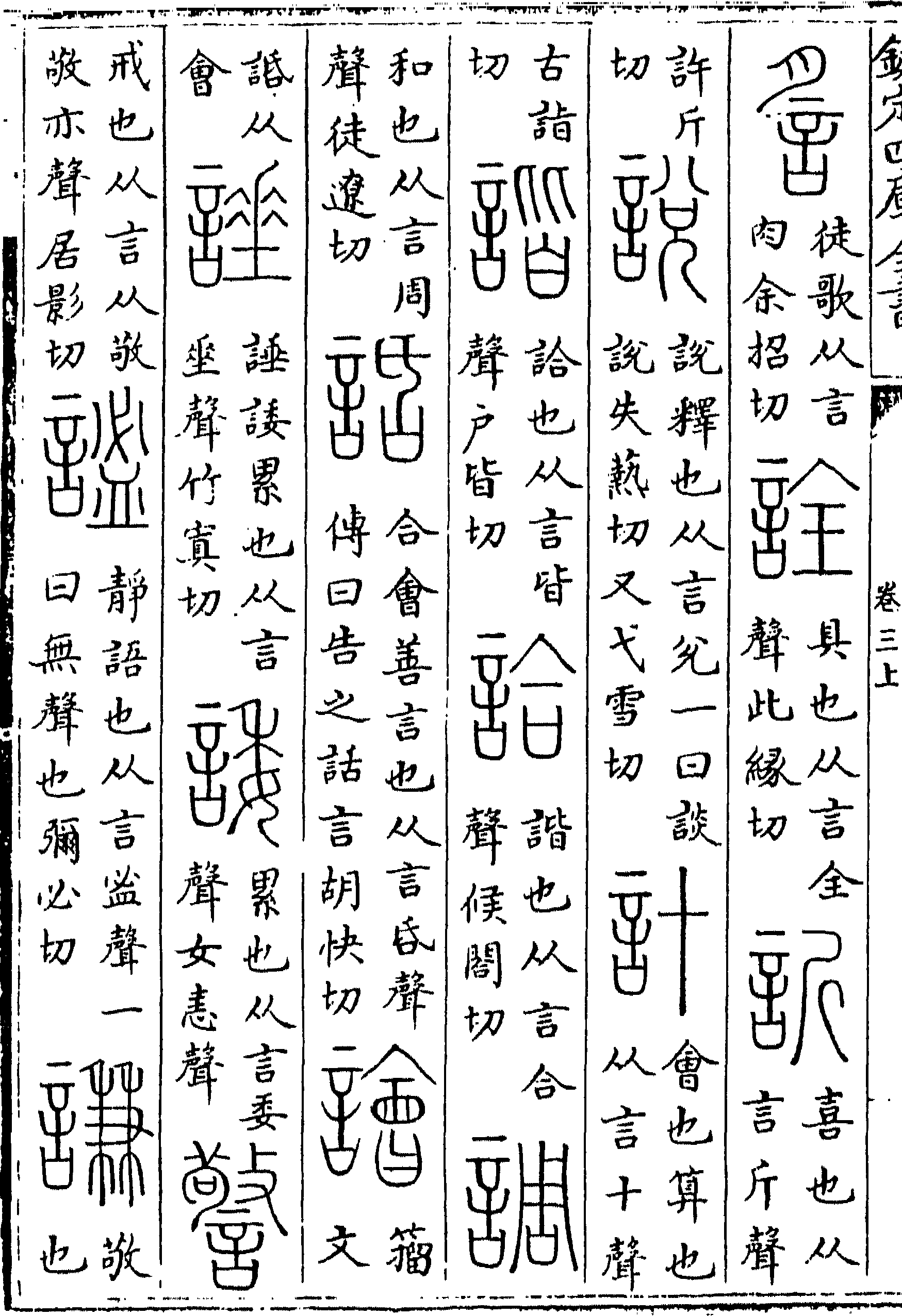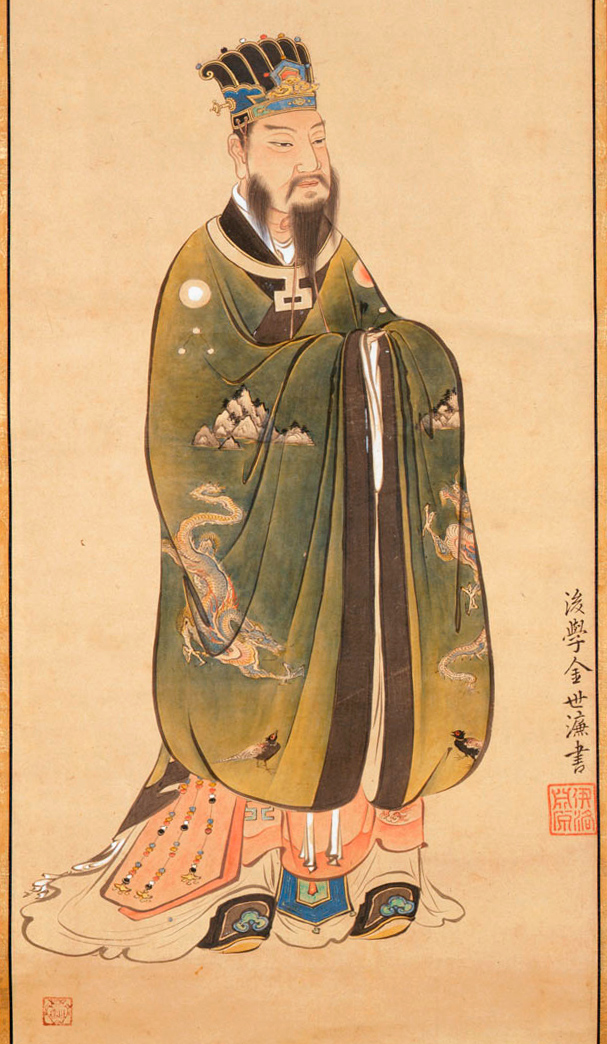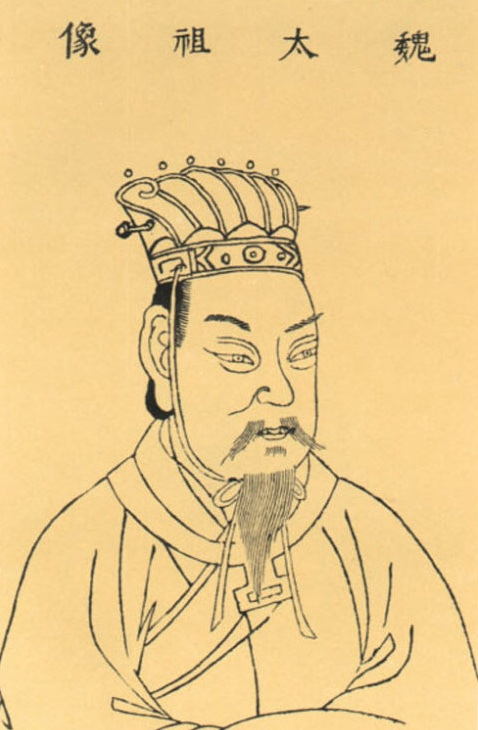|
Qi (state)
Qi, or Ch'i in Wade–Giles romanization, was a state of the Zhou dynasty-era in ancient China, variously reckoned as a march, duchy, and independent kingdom. Its capital was Linzi, located in present-day Shandong. Qi was founded shortly after the Zhou overthrow of Shang in the 11th centuryBC. Its first marquis was Jiang Ziya, minister of King Wen and a legendary figure in Chinese culture. His family ruled Qi for several centuries before it was replaced by the Tian family in 386BC. In 221BC, Qi was the final major state annexed by Qin during its unification of China. History Foundation During the Zhou conquest of Shang, Jiang Ziya, a native of Ju County served as the chief minister to King Wu. After King Wu's death, Ziya remained loyal to the Duke of Zhou during the Three Guards' failed rebellion against his regency. The Shang prince Wu Geng had joined the revolt along with the Dongyi states of Yan, Xu, and Pugu. These were suppressed by 1039 BC a ... [...More Info...] [...Related Items...] OR: [Wikipedia] [Google] [Baidu] |
Old Chinese Phonology
Scholars have attempted to reconstruct the phonology of Old Chinese from documentary evidence. Although the writing system does not describe sounds directly, shared phonetic components of the most ancient Chinese characters are believed to link words that were pronounced similarly at that time. The oldest surviving Chinese verse, in the ''Classic of Poetry'' (''Shijing''), shows which words rhymed in that period. Scholars have compared these bodies of contemporary evidence with the much later Middle Chinese reading pronunciations listed in the '' Qieyun'' rime dictionary published in 601 AD, though this falls short of a phonemic analysis. Supplementary evidence has been drawn from cognates in other Sino-Tibetan languages and in Min Chinese, which split off before the Middle Chinese period, Chinese transcriptions of foreign names, and early borrowings from and by neighbouring languages such as Hmong–Mien, Tai and Tocharian languages. Although many details are disputed, m ... [...More Info...] [...Related Items...] OR: [Wikipedia] [Google] [Baidu] |
Duke (China)
Gong () was the highest title of Chinese nobility during the Zhou Dynasty and the second highest title, ranked below ''Wang'', from the Han Dynasty onwards. ''Gong'' is usually translated as "duke". Examples * Duke Yansheng, the title of the direct descendants of Confucius Confucius ( ; zh, s=, p=Kǒng Fūzǐ, "Master Kǒng"; or commonly zh, s=, p=Kǒngzǐ, labels=no; – ) was a Chinese philosopher and politician of the Spring and Autumn period who is traditionally considered the paragon of Chinese sages. C ... through the main line of descent Chinese honorifics {{China-hist-stub ... [...More Info...] [...Related Items...] OR: [Wikipedia] [Google] [Baidu] |
King Wu Of Zhou
King Wu of Zhou () was the first king of the Zhou dynasty of ancient China. The chronology of his reign is disputed but is generally thought to have begun around 1046 BC and ended three years later in 1043 BC. King Wu's ancestral name was Ji () and given name Fa (). He was the second son of King Wen of Zhou and Queen Taisi. In most accounts, his older brother Bo Yikao was said to have predeceased his father, typically at the hands of King Zhou, the last king of the Shang dynasty; in the ''Book of Rites'', however, it is assumed that his inheritance represented an older tradition among the Zhou of passing over the eldest son.''Book of Rites''Tan Gong I, 1 Accessed 4 Nov 2012. (Fa's grandfather Jili had likewise inherited Zhou despite two older brothers.) Upon his succession, Fa worked with his father-in-law Jiang Ziya to accomplish an unfinished task: overthrowing the Shang dynasty. In 1048 BC, Fa marched down the Yellow River to the Mengjin ford and met with more than ... [...More Info...] [...Related Items...] OR: [Wikipedia] [Google] [Baidu] |
Ju County
Ju County or Juxian () is a county of Rizhao City, in the south of Shandong Province, People's Republic of China. As of the end of 2021, the total registered population of Ju County was 1.167 million. It covers an area of . The Fulaishan Scenic Area () is located on the western border of Ju County. It is noteworthy for an ancient ginkgo tree that grows in the center of the front yard of Dinglin Temple () and is believed to be nearly 4000 years old.The tree is 26.7 meters high and 15.7 meters thick, covering an area of more than 600 square meters. In 1982, UNESCO conducted a special study on this tree and broadcast its close-up to the world. Administrative divisions As 2012, this county is divided to 18 towns and 3 townships. ;Towns ;Townships *Zhailihe Township () *Guozhuang Township () *Kushan Township () Climate Famous people Liu Xie Liu Xie (about 467-539) Word Yan, lived in Dongguan in the Northern and Southern Dynasties, who is the writer of "Wenxindiaolong". S ... [...More Info...] [...Related Items...] OR: [Wikipedia] [Google] [Baidu] |
Battle Of Muye
The Battle of Muye () or Battle of the Mu was a battle fought in ancient China between the rebel Zhou state and the reigning Shang dynasty. The Zhou army, led by Wu of Zhou, defeated the defending army of King Di Xin of Shang at Muye and captured the Shang capital Yin, ending the Shang dynasty. The Zhou victory led to the establishment of the Zhou dynasty, and was used through history as a justified example of the doctrine of the Mandate of Heaven. Background By the 12th century BC, Shang influence extended west to the Wei River valley, a region that was occupied by clans known as the Zhou. King Wen of Zhou, the ruler of the Zhou, who was a Shang vassal, was given the title "Count of the West" by the King Di Xin of Shang (King Zhou). Di Xin used King Wen to guard his rear while he was involved in a south-eastern campaign. Eventually, Di Xin, fearing King Wen's growing power, imprisoned him. Although Wen was later released, the tension between Shang and Zhou grew. Wen pr ... [...More Info...] [...Related Items...] OR: [Wikipedia] [Google] [Baidu] |
Bronze Knife-shaped Coins Of State Of Qi
Bronze is an alloy consisting primarily of copper, commonly with about 12–12.5% tin and often with the addition of other metals (including aluminium, manganese, nickel, or zinc) and sometimes non-metals, such as phosphorus, or metalloids such as arsenic or silicon. These additions produce a range of alloys that may be harder than copper alone, or have other useful properties, such as strength, ductility, or machinability. The archaeological period in which bronze was the hardest metal in widespread use is known as the Bronze Age. The beginning of the Bronze Age in western Eurasia and India is conventionally dated to the mid-4th millennium BCE (~3500 BCE), and to the early 2nd millennium BCE in China; elsewhere it gradually spread across regions. The Bronze Age was followed by the Iron Age starting from about 1300 BCE and reaching most of Eurasia by about 500 BCE, although bronze continued to be much more widely used than it is in modern times. Because historical artworks were ... [...More Info...] [...Related Items...] OR: [Wikipedia] [Google] [Baidu] |
Qin's Wars Of Unification
Qin's wars of unification were a series of military campaigns launched in the late 3rd century BC by the Qin state against the other six major Chinese states — Han, Zhao, Yan, Wei, Chu and Qi. Between 247 BC and 221 BC, Qin had emerged as one of the most powerful of the Seven Warring States in China. In 230 BC, Ying Zheng, the King of Qin, unleashed the final campaigns of the Warring States period, setting out to conquer the remaining states one by one. Following the fall of Qi in 221 BC, China was unified under Qin control. Ying Zheng declared himself "Qin Shi Huang" (meaning "First Emperor of Qin") and established the Qin dynasty, becoming the first sovereign ruler of a unified China. Background Rise of Qin and early conquests Over the course of the Warring States period, the Qin state had evolved to become the most powerful of the seven major states in China, particularly after Shang Yang's reforms in the mid 4th century BC. The other six states would repe ... [...More Info...] [...Related Items...] OR: [Wikipedia] [Google] [Baidu] |
State Of Qin
Qin () was an ancient Chinese state during the Zhou dynasty. Traditionally dated to 897 BC, it took its origin in a reconquest of western lands previously lost to the Rong; its position at the western edge of Chinese civilization permitted expansion and development that was unavailable to its rivals in the North China Plain. Following extensive "Legalist" reform in the fourth century BC, Qin emerged as one of the dominant powers of the Seven Warring States and unified the seven states of China in 221 BC under Qin Shi Huang. It established the Qin dynasty, which was short-lived but greatly influenced later Chinese history. History Founding According to the 2nd century BC historical text '' Records of the Grand Historian'' by Sima Qian, the Qin state traced its origin to Zhuanxu, one of the legendary Five Emperors in ancient times. One of his descendants, Boyi, was granted the family name of Yíng by Emperor Shun. During the Xia and Shang dynasties, the Yíng cla ... [...More Info...] [...Related Items...] OR: [Wikipedia] [Google] [Baidu] |
Chinese Legend
Chinese mythology () is mythology that has been passed down in oral form or recorded in literature in the geographic area now known as Greater China. Chinese mythology includes many varied myths from regional and cultural traditions. Much of the mythology involves exciting stories full of fantastic people and beings, the use of magical powers, often taking place in an exotic mythological place or time. Like many mythologies, Chinese mythology has in the past been believed to be, at least in part, a factual recording of history. Along with Chinese folklore, Chinese mythology forms an important part of Chinese folk religion. Many stories regarding characters and events of the distant past have a double tradition: ones which present a more historicized or euhemerized version and ones which present a more mythological version. Many myths involve the creation and cosmology of the universe and its deities and inhabitants. Some mythology involves creation myths, the origin of things, ... [...More Info...] [...Related Items...] OR: [Wikipedia] [Google] [Baidu] |
King Wen Of Zhou
King Wen of Zhou (; 1152–1050 BC, the Cultured King) was Count of Zhou during the late Shang dynasty in ancient China. Although frequently confused with his fourth son Duke of Zhou, also known as "Lord Zhou", they are different historical persons. Although it was his son Wu who conquered the Shang following the Battle of Muye, Count Wen was posthumously honored as the founder of the Zhou dynasty and posthumously titled King. Many of the hymns of the ''Classic of Poetry'' are praises to the legacy of King Wen. Some consider him the first epic hero of Chinese history. Archaeology Chinese scholars (e.g. Wang Yunwu ( 王雲五), Li Xueqin ( 李学勤), etc.) identified King Wen with a mentioned in inscriptions H11:82 & H11:84 among oracle bones excavated at Zhouyuan (), Qishan County. Biography Born Ji Chang (), Wen was the son of Tairen and Ji Jili, the Count of Zhou, a vassal state of the Kingdom of Shang along the Wei River in present-day Shaanxi. Jili was betrayed a ... [...More Info...] [...Related Items...] OR: [Wikipedia] [Google] [Baidu] |
Chancellor (China)
The grand chancellor (''zaixiang, tsai-hsiang''), also translated as counselor-in-chief, chancellor, chief councillor, chief minister, imperial chancellor, lieutenant chancellor and prime minister, was the highest-ranking executive official in the imperial Chinese government. The term was known by many different names throughout Chinese history, and the exact extent of the powers associated with the position fluctuated greatly, even during a particular dynasty. During the Six Dynasties period, the term denoted a number of power-holders serving as chief administrators, including ''zhongshun jian'' (Inspector General of the Secretariat), ''zhongshu ling'' (President of the Secretariat), ''shizhong'' ( Palace Attendant), ''shangshu ling'' and ''puye'' (president and vice-president of the Department of State Affairs). History In the Spring and Autumn period, Guan Zhong was the first chancellor in China, who became chancellor under the state of Qi in 685 BC. In Qin, during the War ... [...More Info...] [...Related Items...] OR: [Wikipedia] [Google] [Baidu] |
Marquis (China)
The nobility of China was an important feature of the traditional social structure of Ancient China and Imperial China. While the concepts of hereditary sovereign and peerage titles and noble families were featured as early as the semi-mythical, early historical period, a settled system of nobility was established from the Zhou dynasty. In the subsequent millennia, this system was largely maintained in form, with some changes and additions, although the content constantly evolved. After the Song dynasty, most bureaucratic offices were filled through the imperial examination system, undermining the power of the hereditary aristocracy. Historians have noted the disappearance by 1000 AD of the powerful clans that had dominated China. The last, well-developed system of noble titles was established under the Qing dynasty. The Republican Revolution of 1911 ended the official imperial system. Though some noble families maintained their titles and dignity for a time, new political ... [...More Info...] [...Related Items...] OR: [Wikipedia] [Google] [Baidu] |









